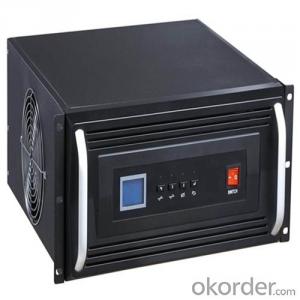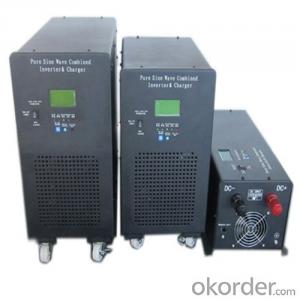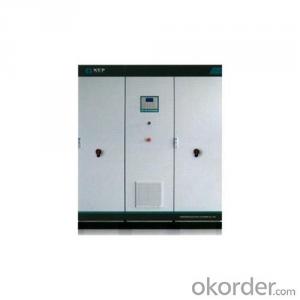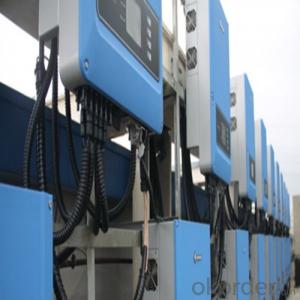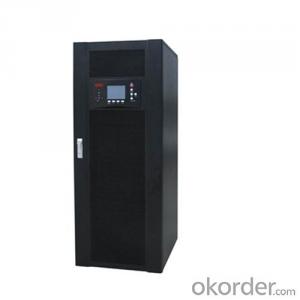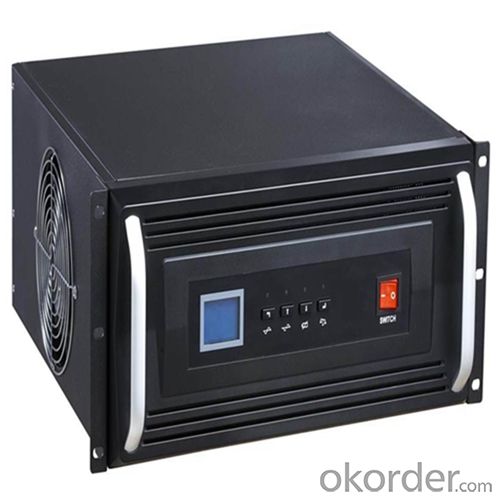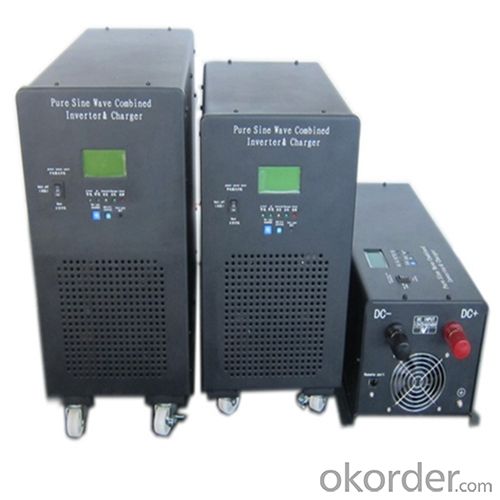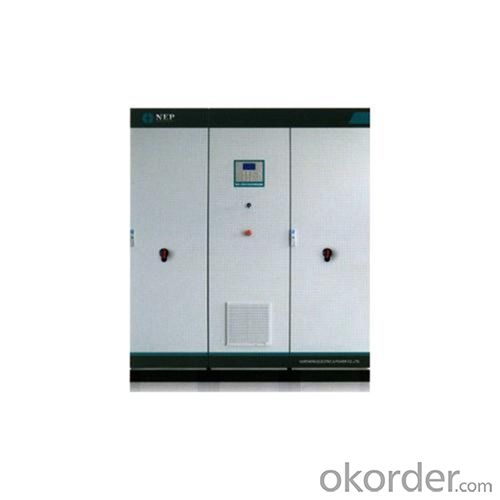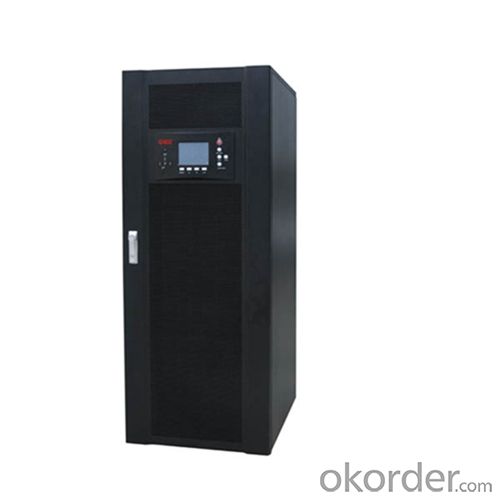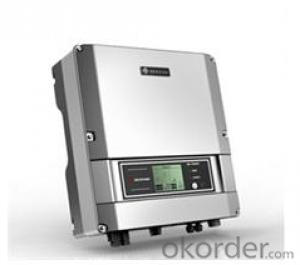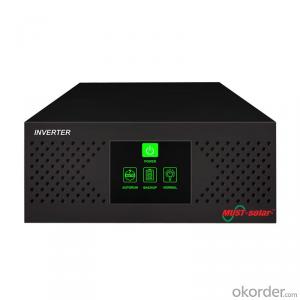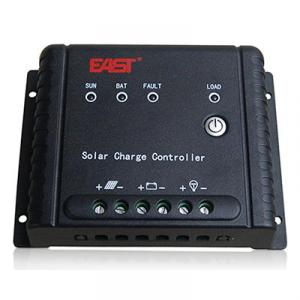1MW Solar Inverter - Certification Solar Power Inverter with MPPT Solar Charger 3000W 24V Pure Sine Wave
- Loading Port:
- Shanghai
- Payment Terms:
- TT OR LC
- Min Order Qty:
- 2 pc
- Supply Capability:
- 3000 pc/month
OKorder Service Pledge
OKorder Financial Service
You Might Also Like
Performance Characteristics
· 1. Suitable for all electrical equipments
· 2. Large LCD display for more detailed content
· 3. CPU controlled; fast transfer time
· 4. Intelligent battery management, prolonging the service life of the battery
· 5. Complete protection function, high reliability
· 6. Can provide high current charge
· 7. Can match different types of batteries
· 8. Disassembled LCD box which can make the operation in a distance of 15 meters
Product introduction
EP series is sine wave low frequency inverter, which is specifically designed for home appliances. It is equipped with a big LCD screen so all information is displayed in detail, which makes it more convenient to use. Charging current of the inverter is adjustable from 5A to 45A and you can also select different charging voltage to charge different types of batteries so batteries are under great protection.
Our Service
Samples
Samples are Available for Testing and Market Test.
Warranty
We provides warranty against defects in materials and workmanship for its Uninterruptible power supply, Power inverter/chargers including inverter12v 24v 48V, Solar charge controllers (“Product”).
OEM Service
OEM service is strictly based on the ISO9001 ISO14001 quality assurance system. The TOP involves the effective teamwork of departments from Sales, R&D, and Engineering, purchasing, production & QA, assuring a high quality product and prompt delivery for customers. The standardization of our quality system and the quality stability has earned us the trust of our customers for 12 years.
We have 10 sets of automatic insertion equipments, ICT PCB testing equipments, ATE automatic testing center and aging workshop for all products. Monthly output of UPS series exceeds 200,000. We have been offering OEM service for over 12 years.
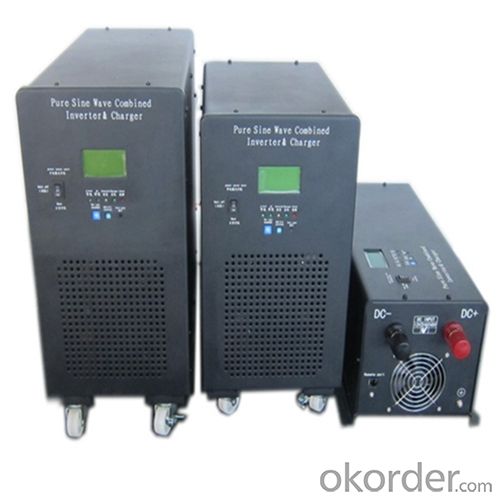
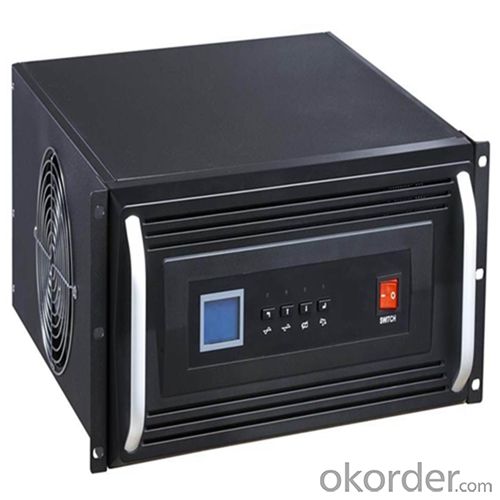
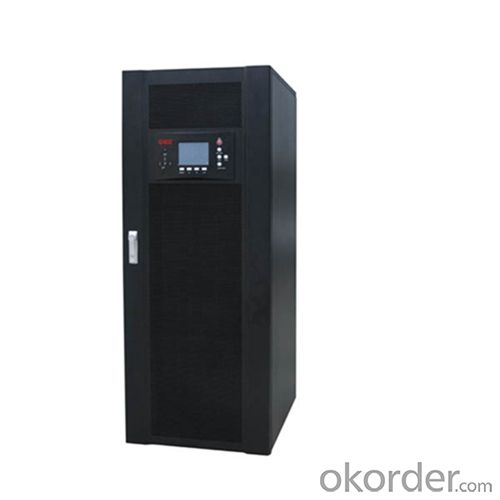

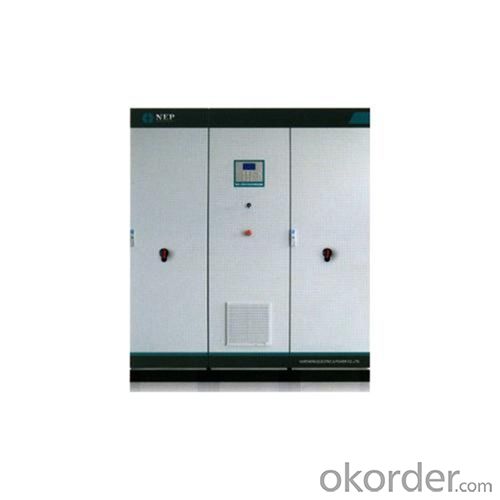
Specifications
Input | |
Input Voltage Range | 182-265VAC |
Output | |
Input Voltage Range | Batt.Mode:50±0.3Hz Mode:48-54Hz(50Hz) or 58-64Hz,Same as AC |
Output Wave Form | Sine Wave (Batt,mode) |
Transfer Time | 10ms(Typical) |
FAQ:
Q: Do you have the CE, TUV, UL Certification?
A: We’ve already passed all the tests, and any certificate is available.
Q: Have you ever sold your products to companies in my country?
A: Of course, we have customers in all general PV markets, but I think we should expand our market share along with the market growth.
Q: When did your company set up? You are a new company, how can I believe your quality?
A: We entered into Solar PV industry in 2005, now we have several plants in manufacturing of a-Si and c-Si panels, and our capacity is 220MW per year. Till now we have already passed all the tests by authorized laboratories, e.g. TUV, CE, UL.
Q: Can you help us install the module if we cooperate with you?
A: We haven’t entered into installation sector, but we have the plan in near future.
Q: How do you pack your products?
A: We have rich experience on how to pack the panels to make sure the safety on shipment when it arrives at the destination.
Q: Can you do OEM for us?
A: Yes, we can.
Q: Can we visit your factory?
A: Surely, I will arrange the trip basing on your business schedule.
- Q: How is the efficiency of a solar inverter measured?
- The efficiency of a solar inverter is typically measured by dividing the output power of the inverter by the input power, and then multiplying the result by 100 to get a percentage value.
- Q: What are the communication protocols used in solar inverters?
- Solar inverters commonly use several communication protocols to enable communication with other devices or systems. Some of the most frequently employed communication protocols in solar inverters include: 1. Modbus: Modbus is an extensively utilized communication protocol for industrial devices, including solar inverters. It facilitates the transmission of data between the inverter and other devices, such as monitoring systems or data loggers. Modbus is well-regarded for its simplicity and flexibility, which contribute to its popularity in the solar industry. 2. SunSpec: SunSpec is a communication protocol specifically designed for the solar industry. It establishes a standardized means for solar inverters to communicate with other devices, such as smart meters or monitoring systems. SunSpec supports both wired and wireless communication, allowing for effortless integration of solar inverters into larger energy management systems. 3. CAN bus: CAN (Controller Area Network) bus is a widely employed communication protocol in various industries, including automotive and industrial applications. It is a robust and reliable protocol that enables high-speed communication between devices. Some solar inverters employ CAN bus to communicate with other devices or systems, ensuring a dependable means of data transfer. 4. Ethernet: Ethernet is a prevalent communication protocol in the IT industry and is also utilized in certain solar inverters. By utilizing Ethernet, solar inverters can communicate with other devices or systems over a local area network (LAN) or the internet. Ethernet offers high-speed communication and can accommodate various communication standards, making it a versatile option for solar inverters. It is essential to note that different solar inverter manufacturers may employ different communication protocols or a combination thereof. The selection of a communication protocol depends on factors such as the specific requirements of the system, compatibility with other devices or systems, and the desired level of integration.
- Q: What is the maximum output power of a solar inverter?
- The maximum output power of a solar inverter depends on its size and specifications. Typical residential solar inverters have a maximum output power ranging from 1 kilowatt (kW) to 10 kW, while commercial and utility-scale inverters can reach several megawatts (MW) of power output.
- Q: What is the role of a grid monitoring feature in a solar inverter?
- The role of a grid monitoring feature in a solar inverter is to constantly monitor the electrical grid to ensure that the solar power generated by the inverter is synchronized with the grid's voltage and frequency. This feature enables the inverter to safely and efficiently inject solar power into the grid, while also providing protection against grid faults and ensuring compliance with grid regulations.
- Q: What are the key safety features to look for in a solar inverter?
- The key safety features to look for in a solar inverter include: 1. Overvoltage and undervoltage protection: This feature ensures that the inverter can handle voltage fluctuations and prevents damage to the electrical system. 2. Ground fault protection: It is essential for the inverter to have ground fault protection to prevent electric shocks and ensure the safety of the system. 3. Anti-islanding protection: This feature ensures that the solar inverter shuts down in the event of a power outage, preventing it from sending power back to the grid and endangering utility workers. 4. Overtemperature protection: A reliable solar inverter should have overtemperature protection to prevent overheating and potential fire hazards. 5. Surge protection: The inverter should have built-in surge protection to safeguard against power surges caused by lightning strikes or grid fluctuations. 6. Arc fault protection: This safety feature detects and mitigates the risk of arc faults, which can result in electrical fires, by rapidly shutting down the inverter. 7. Monitoring and fault detection: A good solar inverter should have a monitoring system that detects faults or abnormalities in real-time, allowing for prompt maintenance and troubleshooting. 8. Compliance with safety standards: Ensure that the solar inverter complies with relevant safety standards, such as UL (Underwriters Laboratories) or IEC (International Electrotechnical Commission), to guarantee its safety and reliability. By considering these key safety features, you can ensure the overall safety and performance of your solar inverter system.
- Q: Can a solar inverter be used in a solar-powered telecommunications system?
- Yes, a solar inverter can be used in a solar-powered telecommunications system. The solar inverter is responsible for converting the direct current (DC) produced by solar panels into alternating current (AC) that can be used to power various devices in the system, including telecommunications equipment.
- Q: What is the role of a solar inverter in a net metering system?
- The role of a solar inverter in a net metering system is to convert the direct current (DC) electricity generated by the solar panels into alternating current (AC) electricity, which is compatible with the electrical grid. The inverter also synchronizes the solar system with the grid, ensuring that excess electricity generated by the solar panels is fed back into the grid, allowing for net metering and the possibility of earning credits for the surplus energy generated.
- Q: How does a solar inverter handle shading or partial panel obstructions?
- A solar inverter handles shading or partial panel obstructions by employing a technique called maximum power point tracking (MPPT). MPPT allows the inverter to constantly monitor the output of each individual solar panel and adjust its operating conditions to maximize power production. When shading or partial obstructions occur, the inverter intelligently redistributes the power flow to avoid any significant drop in overall system performance. This ensures that the panels operate at their optimal efficiency, even under less than ideal conditions.
- Q: Can a solar inverter be used in regions with high levels of dust or debris?
- Yes, a solar inverter can be used in regions with high levels of dust or debris. However, it is important to regularly clean and maintain the inverter to prevent any potential issues caused by the accumulation of dust or debris, which could affect its efficiency and performance.
- Q: What is the role of a remote monitoring system in a solar inverter?
- The role of a remote monitoring system in a solar inverter is to provide real-time data and analysis of the solar inverter's performance and energy generation. It allows for remote access and control, enabling the monitoring and management of the solar system from a central location. This includes monitoring the system's output, identifying and diagnosing any issues or faults, optimizing energy production, and ensuring overall system efficiency and reliability.
Send your message to us
1MW Solar Inverter - Certification Solar Power Inverter with MPPT Solar Charger 3000W 24V Pure Sine Wave
- Loading Port:
- Shanghai
- Payment Terms:
- TT OR LC
- Min Order Qty:
- 2 pc
- Supply Capability:
- 3000 pc/month
OKorder Service Pledge
OKorder Financial Service
Similar products
Hot products
Hot Searches
Related keywords
